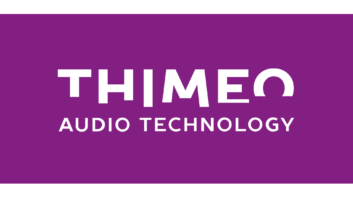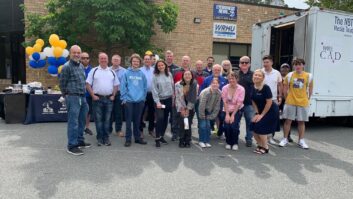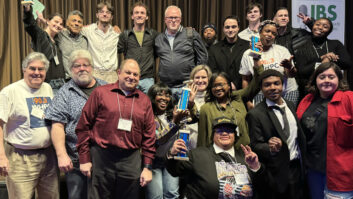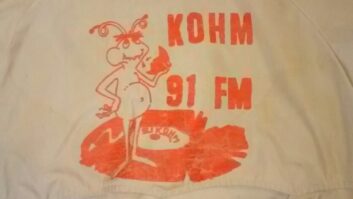
How the audience sees Clouds FM — the launch of the visual radio platform during the station’s annual Fiesta Music Festival. Presenter B12, reggae artist Alaine (left), presenter Vanessa Mdee and singer Mohombi (right).
DAR ES SALAAM, Tanzania —“Cool. Lovable. Outrageous. Unique. Dynamic. Sound.” That was how Joseph Kusaga, the managing director of Clouds Media Group, came up with the name for his new Swahili-language radio station in Tanzania in 1999.
Now he’s in charge of a fast-growing media group that has expanded to include Clouds TV, the English-language radio station Choice FM and event marketing company Primetime Promotions.
Clouds FM was one of the first private radio stations in the country — and part of its early success came from using frequencies at the lower end of the regular FM dial. It recognized that many vehicles in Tanzania had been imported from Japan, and came fitted with radios that only tuned up to 90 MHz.
VISUAL RADIO
The station also invested heavily in its signal quality, using the best transmission and audio processing equipment they could find — the station currently uses an Omnia.11 processor and an Orban Optimod 8600 FM digital processor, with FM transmitters from RVR Elettronica.
It now broadcasts on 20 frequencies across all of Tanzania and into eight surrounding countries. Clouds FM, known as “The People’s Station” — and playing hip-hop, R&B and a local hybrid of the two, Bongo Flava — quickly became number one in the youth market, which makes up around 60 percent of the population of Tanzania.

Vidigo Visual Radio Software in the Clouds FM Production Area From starting off in premises described as “the size of a closet,” the company’s headquarters in Dar es Salaam now houses a TV studio and four well-equipped radio studios. These feature Arrakis consoles, Electro-Voice RE27ND microphones with a Wheatstone Vorsis M2 dual voice processor, and a Telos HX6 talkshow system for callers.
Kusaga says the company’s pioneering spirit remains true to this day, and keeps Clouds FM ahead of the competition. The most recent innovation has been to bring a video element to its radio output, working with media integrator Media Group International. MGI’s Sales Director Paul Wallis flew to Tanzania to tour the studios, and then recommended VidiGo Visual Radio because of its ability to deliver the tools that station staff needs, in a simple-to-use and intuitive package.
This includes VidiGo Live, a software solution for multicamera TV production, coupled with VidiGo Audio Director. This combination makes automatic decisions by analyzing audio signals and using algorithms to make decisions like a real television director as to which camera is up. The graphics and text overlays are then automatically inserted within VidiGo Live, making it possible to superimpose content in a live situation using a station’s own Flash application.
At this early stage, video is used for particular segments where special guests such as politicians or popular artists are in the studio, but the team has plans to expand this to round-the-clock operation. The use of chromakey effects means logos can be inserted around guests; while split screens allow other content, such as local traffic cameras, to be included alongside. This has the added value that the station can offer its clients increased sponsorship opportunities.

Nicole Thadeus uses the Vidigo visual radio software at Clouds FM. AUDIENCE INTERACTION
Kusaga explains that output from the new cameras in the studio will be used in three ways: content for the existing Clouds TV, online where it can also be monetized across different sites, and in January Clouds FM TV was added onto the Clouds bouquet, with the investment allowing them to playout a second channel where the content is already available.
“The system is incredibly easy to operate and, because the cameras are switched automatically on the basis of which mic input is being used, there is very little for our presenters to do,” said Kusaga. “This means they can concentrate on the job of presenting, leaving VidiGo’s software to take care of everything else.”
Audience interaction through social media content is also critical, and the station will be using never.no software, which is integrated within VidiGo to include audience postings on Facebook, Twitter and other platforms within their broadcasts. A Skype module is also included within the software, allowing Clouds to include live content from around the world.

On-air and on-screen in the Clouds FM studio, presenters B12 and Vanessa Mdee interview Nigerian music star Davido. With TV in Tanzania going digital, the company also wanted to expand its reach both domestically and internationally via over-the-top transmission to multiple screens. For this, the station is partnering with Visual Unity to deliver OTT directly to viewers on any screen or connected device anywhere in the world.
The technical infrastructure is based on Visual Unity’s “vuMedia,” which allows broadcasters to manage, monetize and monitor delivery of content to any connected screen and over 7,000 connected devices including legacy phones.

Clouds FM Logo Kusaga says the visual content has proved popular with the target youth audience, around 85–90 percent of whom are viewing via their mobile devices. There are plans to launch a further new TV station broadcasting to the African diaspora across the Middle East and Asia.
But he also adds: “At the end of the day, Clouds FM is still a radio station — one of the most well-respected radio stations in Africa. We’re going visual, and everything is constant change — but we never want to change what’s made us successful.”
Will Jackson reports on the industry for Radio World from London.












